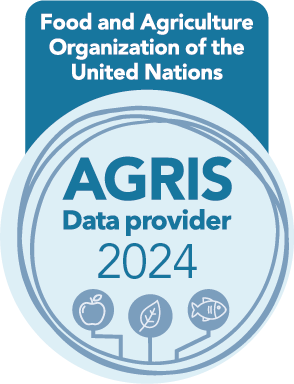Elucidation of genetic diversity in distinct brinjal genotypes: Multivariate analysis using D2
DOI:
https://doi.org/10.14719/pst.4202Keywords:
clusters, distance, divergence, Mahalanobsis method, per cent contributionAbstract
Genetic divergence study among 45 brinjal genotypes was performed using Mahalanobsis D2 statistics to find prospective genotypes for use in a breeding programme. The genotypes were assessed for 11 traits and divided into twelve clusters based on Tocher’s method. Cluster I had the most genotypes (18), followed by cluster III (5), cluster V (4), cluster IV, VI and IX (3 each), cluster II, VII and X (2 each) and cluster VIII, XI and XII (1 each). The intracluster distances ranged between 0 and 1064.87. Cluster X has the largest intra-cluster distance (1064.87), followed by Cluster IV (831.08). Cluster VIII, XI, and XII had the smallest intra-cluster distance (0). The inter-cluster distances varied from 804.88 to 4758.26. The largest inter-cluster distance was between IX and XI (4758.26), followed by III and XII (3923.90), and the shortest distance was between cluster II and III (804.88). Genotypes from the cluster with a large inter-cluster distance could be selected as parents to produce superior F1 hybrids and segregants. The three characters, fruit length (29.70%), number of primary branches (18.89%), and plant height (14.55%), altogether account for 63.14% of overall divergence. As a result, the combination of those traits could be exploited to develop superior varieties with higher yields.
Downloads
References
Zeaven AC, Zhukovsky PM. Dictionary of cultivated plants and their centre of diversity. Wageningen, Netherlands. 1975;219.
Fraikue FB. Unveiling the potential utility of eggplant: a review. Proceedings of the conference of INCEDI 2016;1:883-95.
Das M, Barua N. Pharmacological activities of Solanum melongena Linn. (Brinjal plant). Int J Green Pharm. 2013;7(4). https://doi.org/10.4103/0973-8258.122049
Sindhuja K, Vinithra S, Senthilkumar N, Senthilkumar P, Ponsiva ST, et al. Studies on genetic diversity in brinjal (Solanum melongena L.). Electron J Plant Breed. 2019;10(4):1554-59. https://doi.org/10.5958/0975-928X.2019.00199.6
Islam MA, Ivy NA, Mian MK, Shahadat MK, Shahjahan M. Genetic diversity in exotic eggplant (Solanum melongena L.). Libyan Agric Res Cent J Int. 2011;2(1):15-19.
Banerjee S, Singh BY, Verma A. Genetic diversity of brinjal (Solanum melongena L.) in the foot hills of Himalaya. Int J Curr Microbiol Appl Sci. 2018;7(4):3240-48. https://doi.org/10.20546/ijcmas.2018.704.367
Rao CR. Advanced statistical methods in biometrical research. John Wiley and Sons, Inc. New York; 1952:390.
Singh RK, Chaudhary BD. Biometrical methods in quantitative genetic analysis. Scientific Researcher. Kalyani Publishers, New Delhi; 1977:317.
Zabbar MA, Parveen S, Rahim MA, Huda KM, Arif MA, Sharif MR, et al. Morphological characterization and genetic diversity analysis of yield and yield contributing parameters in brinjal (Solanum melongena L.) genotypes. 2023 Dec 19. https://doi.org/10.21203/rs.3.rs-3744782/v1
Lintu P, Namboodiri RV. Genetic diversity of brinjal (Solanum melongena L.) and its wild relatives. Electron J Plant Breed. 2023;14(1):137-47. https://doi.org/10.37992/2023.1401.014
Devappa V, Venugopalan R. Breeding potential of brinjal (Solanum melongena L.) genotypes using D2 analysis under hill zones of Karnataka, India. Int J Curr Microbiol App Sci. 2020;9(3):2768-73. https://doi.org/10.20546/ijcmas.2020.903.317
Verma HS, Yadav GC, Kumar S, Verma P. Estimation of genetic diversity among the genotypes of brinjal (Solanum melongena L.). J Pharm Innov. 2021;10(8):847-49.
Chaitanya V. Divergence studies in brinjal for yield attributes and shoot and fruit borer incidence. J Pharm Innov. 2022;11(6):1035-38.
Mohanty KK, Mishra H, Barik S. Morphological profiling and assessment of genetic divergence of brinjal (Solanum melongena L.) genotypes. J Pharmacogn Phytochem. 2021;10(1):602-07.
Susmitha J, Eswaran R, Kumar NS. Elucidation of genetic diversity through multivariate analysis in brinjal (Solanum melongena L.) landraces for varietal improvement. J Appl Nat Sci. 2023;15(3):1012-17. https://doi.org/10.31018/jans.v15i3.4694
Solanki AB, Acharya RR. Genetic divergence study in brinjal (Solanum melongena L.). J Pharm Innov. 2021;10(12):986-99.
Kaur S, Sidhu MK, Dhatt AS. Genetic diversity analysis through cluster constellation in brinjal (Solanum melongena L.). Genetika. 2021;53(2):629-40. https://doi.org/10.2298/GENSR2102629K
Khan S, Hussain K, Khan T, Shah LR, Ali G, Dar ZA, et al. Genetic variability, correlation and path analysis for yield components in brinjal (Solanum melongena L.). J Pharm Innov. 2023;12(4):773-81.
Bharathi KI, Shanthi A, Manikandan M. Assessment of genetic diversity of brinjal (Solanum melongena L.) in the coastal region of Karaikal, India. J Sci Res Rep. 2024;30(6):407-11. https://doi.org/10.9734/jsrr/2024/v30i62056

Downloads
Published
How to Cite
Issue
Section
License
Copyright (c) 2025 R Kousalya , S Praneetha, I P Vethamoni, V Ravichandran, K Iyanar, S Varanavasiappan

This work is licensed under a Creative Commons Attribution 4.0 International License.
Copyright and Licence details of published articles
Authors who publish with this journal agree to the following terms:
- Authors retain copyright and grant the journal right of first publication with the work simultaneously licensed under a Creative Commons Attribution License that allows others to share the work with an acknowledgement of the work's authorship and initial publication in this journal.
- Authors are able to enter into separate, additional contractual arrangements for the non-exclusive distribution of the journal's published version of the work (e.g., post it to an institutional repository or publish it in a book), with an acknowledgement of its initial publication in this journal.
Open Access Policy
Plant Science Today is an open access journal. There is no registration required to read any article. All published articles are distributed under the terms of the Creative Commons Attribution License (CC Attribution 4.0), which permits unrestricted use, distribution, and reproduction in any medium, provided the original author and source are credited (https://creativecommons.org/licenses/by/4.0/). Authors are permitted and encouraged to post their work online (e.g., in institutional repositories or on their website) prior to and during the submission process, as it can lead to productive exchanges, as well as earlier and greater citation of published work (See The Effect of Open Access).









